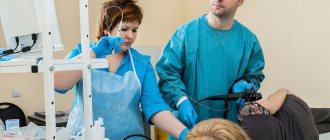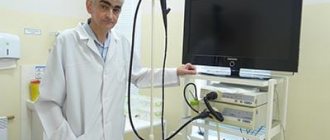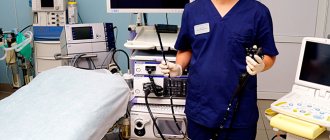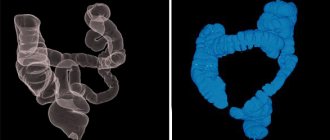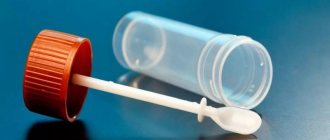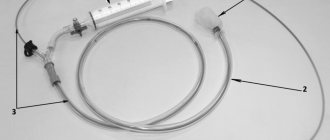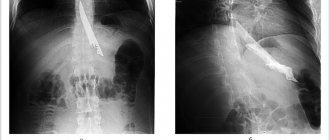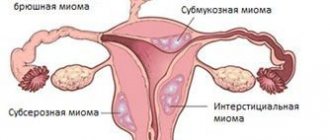pH-impedansometry
Daily pH metry is a study of the functional reactions of the upper gastrointestinal tract, in particular measuring the level of acidity directly in the esophagus, stomach or duodenum. In addition to the pH (acidity) level, impedance metry is carried out during the study, that is, measuring the level of resistance of the gastrointestinal tract environment.
Sufficient production of hydrochloric acid, as well as proper muscular function of the gastrointestinal tract, ensure a normal level of acidity. If this system fails, acid-dependent diseases develop. These include gastroesophageal reflux disease (GERD), the formation of ulcers, and gastritis. If symptoms of any of these pathologies appear, it is important to seek advice from a gastroenterologist, who, based on the collected history, for GERD, gastritis and other diseases, can prescribe daily pH measurements of the stomach and esophagus with monitoring of acidity (pH) for 24 hours.
Purpose of the study
Daily pH impedance monitoring of the esophagus and stomach with acidity monitoring sets the following objectives:
- Assessment of the process of daily production of gastric juice under normal operating conditions of the body, taking into account the influence of external factors (smoking, physical activity, body position, medication) on acidity;
- Diagnosis of gastroesophageal or duodenogastric reflux, the frequency and severity of their manifestation, as well as the degree of aggressiveness of the influence of the contents thrown from the duodenum and stomach onto the mucous membranes of the stomach and esophagus, respectively;
- Detection of factors that provoke the formation of reflux;
- Assessing the effectiveness of prescribed therapy;
- Assessment of the condition of the stomach and esophagus during periods of preparation for surgery and after surgical treatment;
- Designing a schedule of individual acidity rhythms and adjusting the patient’s daily diet taking into account the data obtained;
- Selection of long-acting medications to reduce and control acidity levels.
Indications for intragastric pH measurement:
- apnea;
- heartburn;
- chest pain;
- cough;
- hoarseness and hoarseness of voice;
- widespread recurrent caries;
- bad breath, subject to regular hygiene procedures.
Indications for GERD:
- nonerosive type of disease;
- extraesophageal symptoms (hoarseness of voice, sore throat, chest pain, paroxysmal shortness of breath, dental diseases, association with bronchial asthma);
- refractory form of GERD;
- functional heartburn;
- esophageal hypersensitivity;
- individual selection of antisecretory treatment;
- the period before and after surgery, for example, during gastric resection or elimination of hiatal hernia (hiatal hernia), a disease in which the lower part of the esophagus or stomach is displaced relative to the diaphragm.
Indications
- Gastroesophageal reflux disease (GERD) or the reflux of stomach contents into the esophagus.
- Diagnosis of endoscopically negative GERD (no changes in the esophageal mucosa when performing FGDS).
- Suspicion of extraesophageal manifestations of GERD: chest pain, asthma attacks, hoarseness, etc.
- Heartburn, belching, sour taste in the mouth.
- Peptic ulcer disease.
- Chronic gastritis.
- Zollinger-Ellison disease.
- Monitoring the effectiveness of treatment.
- Selection of an individual treatment regimen.
Contraindications to the procedure
The possibility of conducting daily pH -impedance measurements of the esophagus and stomach is determined individually at an appointment with a gastroenterologist at the UNION CLINIC in St. Petersburg. Absolute contraindications include:
- aortic aneurysm;
- severe maxillofacial injuries;
- gastric bleeding and 10 days after it stops;
- strictures (narrowings), diverticula (pathological protrusions), burns of the esophagus;
- nasopharyngeal obstruction;
- severe coronary insufficiency and hypertension;
- severe coagulopathies (blood clotting disorders).
Introduction and installation of a pH probe to a patient
The introduction, installation to the patient and fixation of transnasal and oral pH-metric probes has a number of specific features, determined both by the anatomy of the cavity organ through which the pH probe is introduced, and the tasks that this study solves. Introduction,
installation to the patient and fixation of transnasal and oral pH-metric metric probes have a number of specific features, determined both by the anatomy of the cavity organ through which the pH probe is inserted, and by the tasks that this study solves.
During long-term pH-metry, the patient leads a “normal” lifestyle: eats, drinks, sleeps, etc. To ensure the possibility of taking food and medications during the day, a pH probe must be passed through the nose. For this purpose, special thin transnasal pH probes are available. In addition, transnasal insertion of a pH probe is more convenient for the patient at night, because There is no need to take special measures to prevent accidental biting of the pH probe during sleep.
When performing express pH-metry, short-term pH-metry, the patient is in the office, sitting in a chair for 30 minutes to 3.5 hours under the constant supervision of medical personnel. For such studies, it is more appropriate to use oral pH probes. Oral pH probes are thicker than transnasal pH probes and therefore have the following advantages. They are easier to introduce into the patient. There is less risk of the pH probe getting wrapped up in the stomach. They are more durable.
Where to do daily pH measurements of the stomach and esophagus in St. Petersburg
You can do pH measurements (impedance measurements) of the stomach and esophagus in the comfortable conditions of the UNION CLINIC day hospital. When you first contact our specialists, you undergo a full examination. The gastroenterologist determines a number of indications and contraindications for the study and helps you prepare for it. Additional tests may be performed before prescribing daily monitoring. During the consultation, you will be able to clarify all the details of the procedure. To make an appointment for pH testing, you can use the online form on the “Make an Appointment” website.
UNION CLINIC uses a modern ambulatory pH recorder to conduct 24-hour pH impedance measurements of the esophagus and stomach. The compact, lightweight device simultaneously records acidity and impedance values, allowing you to classify reflux into acid, gas and mixed, as well as acid and non-acid. This method is especially convenient in determining the specificity of causeless symptoms that occur against the background of non-acid reflux during treatment with proton pump inhibitors (PPIs).
Preparing the patient for the study
During the study, the patient should be on standard diet No. 1 and standard meal times (three times a day). Additional food intake, as well as carbonated drinks, alcohol, and mineral waters are excluded. It is recommended to avoid consuming products that directly or indirectly lower the pH in the gastrointestinal tract, such as fruit and tomato juices, marinades, carbonated drinks, tea, black coffee and yoghurts.
pH probe
The pH probe must be inserted on an empty stomach. If the evacuation of food is disrupted in the evening, the stomach is lavaged through a thick tube until clean water is obtained; if necessary, in the morning the gastric secretions accumulated during the night are evacuated. 12 hours before the test, the patient should not eat or smoke. The intake of liquids is prohibited 3-4 hours before the start of the study to reduce the risk of vomiting and aspiration, as well as to prevent alkalization of gastric contents.
Limiting the intake of medications depends on the duration of their effect: for example, taking antacids and anticholinergics must be discontinued 12 hours before. No less than 72
hours before the study, the use of proton pump blockers is canceled, and the use of H2-blockers 24 hours before the start of the study.
Medical adviser to Medtronic, S. Stendal (1997), gives even more stringent recommendations. Discontinue antacids 24 hours before the study, proton pump inhibitors - 7 days, all other antisecretory drugs - 48 hours. It is advisable to take food or the study drug no earlier than 40 minutes after the start of the study.
The doctor must find out the symptoms the patient has (especially important for pH-metry of the esophagus), what treatment is currently being carried out, the presence of allergic reactions, and explain the study procedure to the patient in detail for better tolerability.
For 24-hour or longer studies, the patient must be instructed about his actions during this period. During daily pH-metry it is recommended:
- remain in normal (physiological) conditions for the patient;
- continue the usual diet (preferably with the exception of mineral waters, acidic foods and liquids, alcohol);
- keep a diary where the patient must note various temporary events and their duration.
For correct analysis of pH-grams of the esophagus, it is important to note periods of being in a horizontal position, whether they coincide with sleep or not. If possible, it is advisable to remain in an upright position during the day: sitting, standing or walking, and lying down only at night to sleep. You need to sleep in a horizontal position, without placing more than one pillow under your head.
To assess the effect of medications, it is necessary to indicate the exact time of their administration. The specific form of the diary (number of different periods, symptoms, etc.) depends on the tasks facing the doctor. As an example, in table. 3.1 and 3.2 show two different versions of the patient's diary. In the diary (Table 3.2) it is recommended to have about 40 lines to record events.
Although devices for long-term pH monitoring have keys for entering various periods and events during the study, it is recommended to duplicate these data in the diary, since patients often forget to mark them or mark them incorrectly. In such situations, this data is entered from the diary into the computer manually.
How is pH testing performed?
Conducting intragastric and esophageal pH measurements is the main method for diagnosing acid-related diseases of the gastrointestinal tract. A probe with a thickness of 1-2 mm is used for the study. It is carefully and painlessly inserted through the nose into the esophagus and further, without interfering with natural breathing and food intake. A new, sterile, disposable probe is used for each patient.
Research stages:
- After insertion, the end of the probe is left in the stomach or moved lower to the duodenum, if required by the initial diagnostic purpose.
- To record data, the probe is attached to a compact recorder, which is attached to the patient's shoulder or belt for the entire duration of information collection (24 hours).
- An electrode is fixed on the collarbone, which helps to capture and record control signals.
- During the entire study, you adhere to your normal rhythm and lifestyle so that the recorder’s readings are as objective as possible.
- Upon completion of data collection, the probe is easily and painlessly removed, after which you can continue your normal lifestyle without restrictions.
The results of the study are usually ready within 1-2 days after removing the probe and removing the recorder. You can discuss the collected indicators during a follow-up consultation with a gastroenterologist.
Intracavitary pH-metry as a modern method for studying gastric secretion
Doctor of Medical Sciences, Associate Professor V.V. Skvortsov, Ph.D. A.V. Tumarenko, E.M. Skvortsova, V.V. Odintsov
Almost all diseases of the upper gastrointestinal tract (GIT) are, to one degree or another, correlated with the effect of acid produced during the digestion process on the mucous membrane of the GI tract. For correct diagnosis (and sometimes treatment) of many of these diseases, it is necessary to study the acid-producing and acid-neutralizing functions of the gastrointestinal tract. The possibility of determining intragastric acidity using a special pH-metric probe was first described by McCledon in 1915.
Until the early 80s of the twentieth century, the goal of developing equipment for intragastric pH-metry was to substantiate the need for the method and create pioneering medical techniques. The first serial devices and pH probes in the USSR were designed in the city of Fryazino, Moscow Region, under the leadership of Academician of the Russian Academy of Sciences N.D. Devyatkova. In the last decade, the leading role in the development and production of domestic devices for intracavitary pH-metry belongs to the Fryazino research and production enterprise Istok-System.
Clinical problems solved using intragastric pH-metry. The advent of pH-metric instruments initiated the development of clinical studies of acid-dependent processes in the human body. pH-metry is of particular importance in the diagnosis of GERD. According to the “Recommendations for the examination and treatment of patients with gastroesophageal reflux disease” (Ivashkin V.T. et al., 2001), “The main method for diagnosing GERD is pH-metry.” However, the diagnosis of GERD, although the most recognized, is far from the only area of application of pH-metry. In modern medicine, pH measurement is used to solve the following problems.
Diagnostic tasks
Among them, the most relevant are: - topographic intragastric express pH-metry of the gastrointestinal tract - short-term (up to 3 hours) study of basal and stimulated secretion of gastrointestinal tract; — long-term (up to 24 hours or more) monitoring of gastroesophageal reflux (GER); — study of fast acid processes, such as duodenogastric reflux (DGR); — parietal intraendoscopic pH-metry; - long-term monitoring of acidity in the esophagus in order to study the role of GER in bronchopulmonary and ENT diseases: chronic cough, pneumonia, bronchial asthma, sinusitis, dysphonia, laryngitis, broncho-obstruction, contact granuloma, pharyngitis, dental erosion, malignant lesions of the pharynx, larynx, vocal cords, as well as research into the role of GER in the occurrence and development of sleep diseases; — simultaneous long-term monitoring of acidity in the gastrointestinal tract and electrical activity of the heart for the purpose of differential diagnosis of cardio- and gastrointestinal diseases and for the study of heart diseases caused by GER; simultaneous monitoring of acidity in the gastrointestinal tract and electrical activity of various parts of the gastrointestinal tract. Tasks associated with assessing the effects of pharmacological drugs: - selection of drugs and their dosages for optimal drug treatment of specific patients; — assessment of the effectiveness of drugs (or complexes of drugs) on patients suffering from certain diseases; — research related to obtaining permits for the use of certain pharmacological drugs in medical practice.
Devices for intracavitary pH-metry are in demand in solving numerous research problems, among which, in addition to the creation and testing of new methods for diagnosing and treating diseases of the gastrointestinal tract, including combined ones, we note the study of acid-dependent processes in the lower parts of the gastrointestinal tract, in the oral cavity, intravaginal and transurethral pH-metry.
Devices for intracavitary pH-metry
1. Microprocessor acidogastrometer “AGM-03” is the basic device of a series of inexpensive acidogastrometers. Designed for studying basal and stimulated acidity of the gastrointestinal tract, conducting alkaline, acid and other tests, as well as for selecting medications. A separate area of its application is topographic intraendoscopic pH-metry.
2. Computer stationary acidogastrometer “Gastroscan-5M”. Designed for short-term (including stimulated) pH-metry of the gastrointestinal tract in up to five patients simultaneously, in one, two, three or five sections of the gastrointestinal tract. The pH measurement period is 20 or 5 s. Gives tips to medical personnel on conducting the examination. Issues a conclusion about the state of the gastrointestinal tract. Saves research results in a database and performs various types of statistical processing of the research array. Allows for individual selection of drug therapy.
3. Daily wearable acidogastromonitor “Gastroscan-24”. The Gastroscan-24 computer device is intended for long-term (up to 24 hours or more) study of the acidity of the gastrointestinal tract. For processing, the measurement results after the end of the examination are transferred to a personal computer (PC). The device allows you to evaluate the effect of medications, select them and take them. During the study, using the keyboard equipped with the wearable unit, the patient enters data about his condition (pain, heartburn, nausea, etc.) or actions (smoking, taking medications, etc.).
4. Gastrocardiomonitor “Gastroscan-ECG”. The device is designed for simultaneous 24-hour monitoring of acidity at three points in the gastrointestinal tract and cardiac signal in three leads. Such monitoring allows for differential diagnosis of chest pain of unknown etiology based on correlation analysis of changes in acidity and cardiac signal.
5. pH-metric probes. NPP "Istok-System" serially produces a variety of pH probes that differ in design and application: a) oral, transnasal, endoscopic; b) having 1, 2, 3 or 5 measuring electrodes; c) in age versions approved by the Ministry of Health of the Russian Federation - 4 children and 1 adult (multielectrode pH probes). All pH probes provide a measurement accuracy of 0.2 pH over a range of 1.1 to 9.2 pH. Currently, gastroenterology is one of the fastest growing areas of therapy. To a large extent, this progress is due to the introduction into clinical practice of modern, high-tech methods for studying the functions of the digestive organs.
On the other hand, knowledge of the physiology of the processes of secretion, digestion, and motility in the gastrointestinal tract is expanding every year, which forces, in some cases, to rethink the methods, purpose and interpretation of the results of traditional, routinely used research methods in gastroenterology. Until relatively recently, functional diagnostics in gastroenterology was a tool in the hands of a few researchers, with the help of which they could assess the degree of dysfunction of a particular organ of the digestive tract.
Currently, a large amount of factual material has been accumulated, which allows not only to diagnose the severity of functional disorders, but also, importantly, to verify the patient’s diagnosis.
Gastrointestinal intubation for pH measurement
Contraindications. In each specific case, it is necessary to correlate the severity of the patient’s condition and the expected diagnostic value of the study. The use of microprobes reduces the number of contraindications to probing. However, the question of the appropriateness of this study must be decided individually in the following cases: diseases of the oral cavity, nose, pharynx that prevent the insertion of a probe or the patient’s breathing; diverticula, esophageal strictures; severe uncontrolled coagulopathy; bronchial asthma, cardiovascular diseases, in which stimulation of the vagus nerve is contraindicated; severe respiratory failure; recent gastric surgery; tumors and ulcers of the esophagus; varicose veins of the esophagus; mental illnesses (neuroses, psychopathy, hysteria) in the absence of mutual understanding with the patient.
Complications of intubation: bleeding from the nose or throat; injury to the nose or throat; tracheal intubation; trauma or perforation of the esophagus, stomach; vomit; syncope associated with irritation of the sensitive afferent fibers of the vagus nerve system, due to the initiation of the vasovagal reflex (an efferent discharge occurs, conducted along the motor fibers of the vagus nerve and causing cardiac arrest); bronchospasm; exacerbation of trigeminal neuralgia; patient infection.
Probing equipment for pH measurements: probe; aerosol, gel for anesthesia; vomit tray; towel; rubber gloves, portable pH meter.
Preparation for pH-metry Intubation is carried out no less than 6 hours after eating. 3-4 hours before the start of the study, smoking, drinking liquids, and chewing gum are excluded. If the evacuation of contents from the stomach is impaired on the evening before the study, the stomach is lavaged through a thick probe until clean lavage water is obtained. Before the study, it is necessary to clarify what medications the patient took on the eve of the study. Most methods require discontinuation of previous medications. The time for limiting the intake of medications depends on the duration of their effect and the method used, for example, with pH-metry, antacids and anticholinergics must be discontinued 12 hours before, H2-histamine blockers 24 hours before, and proton pump inhibitors 36 hours before.
It is important to carefully study the patient’s medical history and listen to his complaints at the time of the study. This is necessary to exclude the patient from possible contraindications for the study, allergies to medications used for anesthesia. In order to reduce neuropsychic stress and prevent complications during the study, it is necessary to explain the procedure to the patient and note its safety.
Intubation technique
Immediately before the test, place the probe in warm water for a while to minimize temperature changes in the catheter and increase its elasticity. Place the patient in a chair. If the probe is inserted through the nose, ask the patient to breathe deeply with the mouth closed, alternately pinching one of the nostrils, to assess nasal breathing. Intubation is carried out through the nasal passage with the most effective nasal breathing. Test the gag reflex by touching the uvula or pharynx. Patients with a weak or absent gag reflex are at greatest risk for pulmonary aspiration. If there is no allergy to the drug, anesthesia of the nasal passage or pharynx is performed with an aerosol anesthetic (lidocaine, etc.). However, some patients tolerate repeated examinations well even without local anesthesia. After the onset of anesthesia, the probe is slowly and carefully inserted into the nasal passage, or into the mouth, and then into the patient’s throat. When inserting a probe into the nasopharynx, the patient is recommended to tilt his head forward so that the chin touches the chest. Tilt of the head forward leads to the closure of the trachea by the epiglottis and facilitates the passage of the probe into the esophagus. At the moment of insertion of the probe, the patient breathes deeply and makes swallowing movements. The appearance of a cough indicates that the probe is not installed correctly. If there is hypertonicity of the lower esophageal sphincter (achalasia cardia), the probe may twist in the distal part of the esophagus. In this case, it is necessary to remove the probe and slowly insert it again. The probe advances to the desired depth. During the study, it is necessary to monitor the patient's reaction, since gastric intubation and fear can lead to acute vasomotor reactions, including loss of consciousness. The probe is secured with a patch on the cheek and behind the ear.
Before starting the study, it is necessary to allow the patient to get used to the probe. In most studies, saliva is spat into a special tray. To conduct the study, equipment is used for long-term monitoring of acidity, consisting of a compact wearable pH recording unit, to which is attached a pH-metric probe, inserted transnasally into the patient’s stomach, and a computer with software. The panel of the wearable unit has special buttons, by pressing which the patient registers in the device’s memory the time of occurrence and duration of pain, dyspeptic symptoms, food intake and other events. Intracavitary pH is determined at set time intervals from 1 to 60 s in various devices.
pH is measured on an empty stomach in the body and antrum (6-7), normally in the antrum after administration of histamine pH = 4-7. The conditional norm for stimulating secretion with extractive substances is considered to be pH = 1.7-1.5 in the body of the stomach, and with maximum stimulation with histamine - 1.2-1.1. If the pH remains above 1.8 during histamine stimulation, then the likelihood of atrophy of the gastric mucosa is significant.
To assess intragastric acidity, the following types of intragastric pH measurements are used: Topographic express pH measurements. Intragastric pH monitoring. Topographic transendoscopic pH-metry. Topographic intragastric express pH-metry A probe is inserted into the patient's esophagus on an empty stomach up to the lower esophageal sphincter. The length of insertion of the probe is approximately determined by the distance from the patient’s earlobe to the xiphoid process or from the upper lip to the navel. Then, as the probe is further introduced, pH measurements are taken every centimeter. A total of 20 pH measurements are taken for no more than 3 minutes. The probe is fixed and left in the stomach for 10 minutes. After 10 minutes, the probe is removed, and the pH is also measured every centimeter. For the study, acidogastrometers AGM-01, AGM-03 and Gastroscan-5M are used. The pH values upon insertion of the probe determine the level of fasting acid formation. pH values when removing the probe allow you to assess the level of basal acid formation. When performing pH measurements, it is important to consider in which part of the stomach the sensor is located.
In the antrum of the stomach, in most cases the pH is higher due to the neutralization of hydrochloric acid by the alkaline secretion of the glands. At the same time, the degree of severity of the acid-neutralizing function of the stomach is determined by the difference in pH between the antrum and body of the stomach. If the pH difference is 2.1 or more, compensated alkalization is diagnosed, 1.0-2.0 - subcompensated, 1.0 or less - decompensated alkalization in the antrum. There are research schemes when the pH is recorded for 45 minutes under basal conditions, and then over the next 45 minutes after stimulation of secretion. To stimulate gastric acid formation, the same medications are used as for multi-stage gastric intubation (histamine dihydrochloride, histamine phosphate, gastrin (2 mcg/kg), pentagastrin (pentavlon) at a dose of 6 mcg/kg, etc.
The main disadvantage of the method is the inability to estimate the volume of gastric contents and, as a result, acid production. However, the Neller alkaline test helps to indirectly assess acid production. The alkaline test involves introducing a solution of 0.5 g of baking soda (NaHCO3) into 30 ml of boiled water through the pH probe channel. It is carried out 20 minutes after stabilization of the pH under basal conditions or 45 minutes after the introduction of stimulants. This technique allows you to get an idea not only of the concentration of hydrogen ions in the lumen of the stomach, but also of the amount of gastric juice, i.e. hydrochloric acid products. The indicator of this test is the alkaline time - the interval between the increase in pH after the introduction of the solution until it returns to the original level. Normally, in the body of the stomach it ranges from 15 to 30 minutes. A decrease in alkaline time of less than 15 minutes indicates an increase in the flow rate of hydrochloric acid, an increase of more than 30 minutes indicates a suppression of acid formation.
The test is carried out under basal and stimulated conditions. If acid formation is high, an atropine test is performed. It makes it possible to differentiate the neuroreflex mechanism of basal acid production from the humoral one. The test is carried out both under basal conditions and when secretion is stimulated. In this case, 1 ml of a 0.1% solution of atropine sulfate is injected subcutaneously and the pH in the body of the stomach is recorded for an hour. The results of the atropine test under basal conditions are assessed by the degree of pH increase in the body of the stomach. When the pH increases by more than 2 units. - the effect is strong, from 1.1 to 2.0 - medium, from 0.5 to 1.0 - weak, up to 0.5 - negative. When assessing the test results, it is necessary to take into account that anticholinergics primarily reduce the volume of acid production, having little effect on the concentration of hydrochloric acid in gastric secretions.
Intragastric long-term pH monitoring
The method allows you to: evaluate the daily rhythm and intensity of hydrochloric acid secretion; assess the speed of onset and duration of the effect of antisecretory drugs; correlate the occurrence of symptoms of an acid-dependent disease with fluctuations in intragastric pH; differentiate chest pain of cardiac and non-cardiac origin. To conduct the study, equipment is used for long-term monitoring of acidity, consisting of a compact wearable pH recording unit, to which is attached a pH-metric probe, inserted transnasally into the patient’s stomach, and a computer with software.
The panel of the wearable unit has special buttons, by pressing which the patient registers in the device’s memory the time of occurrence and duration of pain, dyspeptic symptoms, food intake and other events. The pH-metric probe has several electrodes and allows you to simultaneously record pH from 2-3 parts of the stomach. pH is determined at set time intervals from 1 to 60 s in various devices. Not long ago, clinical trials of the acidogastrometric automated complex AGM-24 MP (Gastroscan-24) produced by Istok-System (Fryazino, Moscow Region) were completed at the Federal Gastroenterological Center. The AGM-24 MP device is designed for continuous recording of pH values in the esophagus, stomach and duodenum for 24 hours with a reading interval every 20 seconds. The study is carried out using a pH probe inserted transnasally, connected to a secondary converter (AGM-24 MP acidogastrometer), with subsequent transfer of the data array for processing on a PC. At the end of the examination, information is provided in text and graphic modes about the dynamics of pH during the study. The obtained results are saved in the database.
The AGM-24 MP acidogastrometer is a secondary converter that works with a pH probe. The acidogastrometer is made in a portable version (weight about 500 g) with autonomous power supply from batteries. This allows pH values to be recorded every 20 seconds for 24 hours. The device is equipped with a symbolic-digital indicator that allows you to control its operation. The presence of 15 keys allows you to both set the operating mode of the device (calibration, data reading, start and end of work), and mark various time intervals and events during the examination of the patient (eating, medications, pain, heartburn, etc.). The pH probes used in this study consist of 2 mm diameter antimony measuring electrodes mounted in a 2.0 mm diameter polymer tube and an external silver chloride reference electrode. The probes have three main types: with one (G1), with two (G2) and three (G3) measuring electrodes.
For patients of different age groups, the transducers are made with interelectrode distances of 50, 70, 90, 110 and 120 mm. The software included in the Gastroscan-24 system is designed to run on an IBM PC-compatible PC. The software package includes files with a database, files for conducting examinations, files with instructions for operating the complex, and demo files. This program allows you to analyze the data obtained over various time intervals and save research data in a database.
Also, NPP Istok-System produces equipment for conducting traditional studies of gastric secretion within two to five hours (“Gastroscan-5M”, “Gastroscan-5”, “Gastroscan”, “AGM-03”), which can be used in work functional diagnostic rooms, gastroenterological and surgical departments of hospitals, clinics and diagnostic centers, as well as in scientific research. These devices are equipped with pH probes, which have from one to five pH sensors with a diameter of 7 to 1.8 mm, which makes it possible to measure pH through the instrumental channel of the fiberscope.
Topographic transendoscopic pH-metry
Allows visual control of the pH measurement site and functionally complements endoscopic examination. The method is based on an analysis of the functional state of zones of acid formation and neutralization of secretions during endoscopic examination. The study is carried out by measuring pH values through a pH-metric probe placed in the endoscopic channel of the endoscope. For the study, acidogastrometers AGM-01, AGM-03, and Gastrotest MK-90 are used. Before the study, it is advisable to pass a pH-metric probe with a measuring electrode through the biopsy channel of the endoscope to the level of its outlet at the distal end. This will prevent possible contact of the electrode with thick mucus of gastric contents that enters the biopsy channel of the endoscope during suction, which can change the readings of the pH meter. If pH measurement is performed during an endoscopic examination, before inserting the pH probe, the biopsy channel of the endoscope should be washed with 20 ml of sterile distilled water, injecting it into the lumen of the channel with a syringe. To reduce irritation of the mucous membrane, endoscopic examination should be performed with minimal insufflation of the stomach with air.
Determination of pH should be carried out under visual control with moderate pressure of the electrode on the mucous membrane (until a slight funnel-shaped “crater” appears around the electrode). Contact of the electrode with the mucous membrane is carried out for 5-10 s, the measurement results are recorded and read from the acidogastrometer indicator. If there is no contact, the pH values will be incorrect and may be below 0.8. pH values can vary depending on the pressure of the probe on the mucous membrane and the angle of attack of the probe to the surface of the gastric mucosa. For more reliable readings, it is recommended to measure pH three times at each control point and calculate the average result. Long-term monitoring of pH in the upper parts of the digestive tract allows us to identify gastroesophageal and duodenogastric reflux, determine the acid-forming function of the stomach after surgical interventions on the stomach, and also provides the opportunity for individual selection of the dose and regimen of taking an antisecretory drug and monitoring the treatment. In the process of studying the profile of 24-hour intragastric acidity in healthy people, a daily circadian rhythm of hydrochloric acid production was revealed and its significant changes in patients with chronic gastritis (antral, gastric body, pangastritis), duodenitis (anthropyloroduodenitis), peptic ulcer, reflux esophagitis.
Based on this study, it is possible in most cases to differentiate autoimmune gastritis (up to achlorhydria as a result of atrophy of parietal cells) from Helicobacter gastritis. The latter never manifests itself as achlorhydria, since in this form of gastritis the atrophic process is focal in nature, and in antral gastritis, antropylorobulbitis, peptic ulcer with localization of the ulcer in the outlet of the stomach and in the duodenal bulb, the acid-producing function is usually increased, especially at night. In case of reflux esophagitis and insufficiency of the lower esophageal sphincter, using this method, reflux of acidic gastric contents is detected, and it is also possible to study the frequency and duration of refluxes. It is extremely important that this method allows one to evaluate the effect of various drugs on the intraesophageal and intragastric environment depending on the dose, route of administration and time of administration.
Literature
1. Beatty A.D. Diagnostic tests in gastroenterology: Translated from English - M.: Medicine, 1995. - 224 p.
2. Gastroenterology. — P/ed. J. Barona, F. G. Moody. - M., Medicine. -1988. —TI
3. Grozdova T.Yu., Chernenkov Yu.V. Current issues in pediatric gastroenterology “Gastric acid formation (research methods, clinical significance, correction of therapy)” - Educational and methodological manual. - Saratov, 1998. - 44 p.
4. Gastrointestinal hormones and pathology of the digestive system: trans. from English — P/ed. M. Grossman. - M.: Medicine, 1981. - 272 p.
5. Laboratory research methods in the clinic: Handbook / Menshikov V.V., Delectorskaya L.N., Zolotnitskaya R.P. and etc.; Ed. Menshikova V.V. - M.: 1987.- 368 p.
6. Leya Yu.Ya. Modern assessment of gastric acid formation // Clinical. medicine. - 1996. - T. 74, N 3. - P. 13 -16.
7. Leya Yu. A., Birgale E. L., Linar E. Yu. Normal gastric acid formation according to intragastric pH-metry. //Ter. archive. - 1984. - No. 2. - P. 40-42.
8. On the unification of methods for studying the secretory (acid-forming) function of the stomach: methodological. recommendations for students, interns and general practitioners. — Ed. V.V. Nedogody. - Volgograd, 1986.
9. Okhlobystin A.V. Use of intragastric pH-metry in clinical practice / guidelines for doctors. - Moscow, 1996. - 32 p.
10. Sablin O.A., Bogdanov I.V. The use of intraesophageal rheography for the diagnosis of gastroesophageal reflux disease // Russian Journal of Gastroenterology, Hepatology, Coloproctology. - 1998. - T. 8, N 5. - P. 9-10.
11. Sablin O.A., Grinevich V.B., Uspensky Yu.P., Ratnikov V.A. Functional diagnostics in gastroenterology: educational and methodological manual. - St. Petersburg, 2002.
12. Trifonov M.M. Intracavitary pH-metry is the “gold standard” in gastroenterology, pulmonology and other areas of medicine. Practical Medicine. - 2003. - No. 3.
13. Udaltsov B.B. Intragastric electrometric studies in gastroduodenal diseases: Dis. ...cand. honey. nauk.- L., 1981. - 172 p.
14. Zimmerman Ya.S., Verzhbitsky F.R. New criteria for assessing the acid-forming function of the stomach using intragastric pH-metry // New methods of diagnosis and treatment in gastroenterology. - Perm, 1983. - pp. 3-7.
15. Chernov V.N., Chebotarev A.N., Donskov A.M. Gastroenterology (research methods, instruments, automated systems and choice of treatment method). - Rostov n/d, Publishing house Rost. University, 1997.- 464 p.
16. Yakovenko A.V. Modern methods of studying gastric secretion // Attending physician. - 1999. - No. 6.
17. Baron JH The clinical use of gastic function tests. — Scand. J. Gastroenterol., Suppl.. -1970, 6. - P. 9-46.
18. Kay AW Effect of large doses of histamine on gastric secretion of HCl; an augmented histamine test. — Br. Med. J. - 1953. - R. 77-80.
19. Stendal C. Practical guide to gastrointestinal function testing. - Tennessee: Blackwell Science, 1997. - 281 rub.
The article was published on the website https://www.gastroscan.ru
Tranasal administration of a pH probe
The experience of various researchers shows that passing a pH probe through the nose causes nausea and vomiting significantly less often.
When performing intubation, possible complications should be taken into account - damage to the nasal mucosa, pharynx (bleeding), nasotracheal intubation, perforation of the esophagus or stomach, vomiting, bronchospasm, trigeminal neuralgia, transmission of infection. In some cases, patients develop rhinorrhea during the study, however, this does not serve as a reason to stop the study; moreover, it reduces the irritating effect of the pH probe on the nasopharyngeal mucosa (A.V. Yakovenko, 2001).
Caution should be exercised when introducing a transnasal pH probe in patients suffering from rhinitis, deviated nasal septum, and nasal polyps. These diseases should be considered relative contraindications to the study. Some patients do not tolerate prolonged contact of the pH probe with the mucous membrane of the nasal cavity and nasopharynx. Developing acute rhinitis may be the reason for premature termination of the procedure. Before inserting the pH probe, it must be warmed in warm water, which makes it softer and reduces the patient’s discomfort.
The pH probe is inserted with the patient sitting. The patient is asked to inhale alternately through the right and left nostrils to determine the nostril through which the pH probe will be inserted (use the nostril through which it is easier to breathe). Anesthesia of the nose and pharynx is carried out with 10% lidocaine spray or 1-2% 0.5 ml dicaine solution. It is this amount of anesthetic that does not affect pH values (Yu.A. Leya, 1987). It is necessary to take into account the presence of allergic reactions (especially in children). Some authors believe that local anesthesia of the pharynx (by rinsing or irrigating the pharynx with an anesthetic solution) is undesirable, as this may make it difficult for patients to swallow the pH probe and affect the level of gastric secretion. A number of authors recommend applying a small amount of water-soluble anesthetic gel (xylocaine gel) to the tip of the pH probe to facilitate its passage through the nasopharynx.
Do not lubricate the surface of the pH probe with Vaseline, cream or any other organic or mineral oils to facilitate its insertion. As a result, the measuring electrodes become dirty and the accuracy of acidity measurements is significantly reduced (A.G. Mikheev, G.A. Yakovlev, 2002).
The patient tilts his head back, and in this position the pH probe is inserted into the nasal passage until it passes the nasopharyngeal angle. Then the patient slowly tilts his head down towards his chest and, at the moment of swallowing, the pH probe is inserted into the esophagus. The depth of insertion of the pH probe is determined by the purposes of the study. To make it easier to carry out a pH probe, the patient can be given water to drink through a “straw” without lifting the chin.
The pH probe should pass freely without significant effort or coughing
The pH probe should pass freely without significant effort or coughing. The appearance of a cough indicates that its position is incorrect (insertion into the trachea). In this case, you should tighten the pH probe and continue its insertion after the cough stops. If gagging occurs, you should temporarily stop inserting the pH probe and ask the patient to take several deep breathing movements. If the lower esophageal sphincter is hypertonic, the pH probe may become coiled in the distal esophagus. In these cases, it should be partially removed and then slowly reintroduced into the stomach.
Considering the various options for installing a pH probe: esophagus-cardia-body; cardia-body-antrum; body-antrum-duodenum with a tricanal pH probe, esophagus-cardia; body-antrum; antrum-duodenum with a two-channel pH probe, we can conduct research in accordance with our goals. When introducing a pH probe into the antrum of the stomach and into the duodenum, it is recommended (A.V. Okhlobystin, 1996) that the patient, after passing the pH probe through the esophagus, does not sit, but stands up and stands while the pH probe passes into these parts of the gastrointestinal tract. This option is less likely to wrap the pH probe in the stomach.
The correct interpretation of measurements significantly depends on the correct installation of the pH probe in the patient. For the convenience of medical personnel, 7 marks are applied to silver chloride oral and transnasal pH probes with an interval of 100±5 mm. The first mark is located at a distance of 300±5 mm from the distal end of the pH probe.
Initially, the pH probe is inserted using the marks on the pH probe as a guide. However, relying on labels alone may not be enough. Therefore, its position should be monitored using fluoroscopy or pH readings (transition from an acidic to a neutral environment when passing a pH probe from the stomach into the esophagus through the lower esophageal sphincter). The X-ray control method is indispensable for determining the position of the pH probe in the stomach in hypo- and anacid conditions, when determining the location of the measuring electrodes of the pH probe relative to the lower esophageal sphincter (LES) using changes in pH values is not possible. If it is necessary to measure pH in the antrum and duodenum, X-ray control of the position of the pH probe is also necessary, since when installing a pH probe in these sections, it is often observed to fold in the stomach when the end electrode is located higher than the rest.
To correctly interpret 24-hour esophageal pH monitoring data according to DeMeester, pH values should be measured 5 cm above the lower esophageal sphincter (Fig. 3.1). Correct determination of the location of the LES makes it possible to determine pH electrodes in any part of the stomach and esophagus with an accuracy of 1 cm. The localization of the LES can be determined using manometry, by a characteristic change in the pH value during insertion and x-ray. The manometric method is the most accurate, as it allows one to identify an area of increased pressure corresponding to the anatomical position of the LES. Unfortunately, this method remains inaccessible, as it requires special equipment.
When determining the location of the LES using pH-metry (step-by-step method), the pH electrode(s) are first passed into the stomach, as evidenced by a change in pH values from 6-7 units. (esophagus) up to 1 -2 units. (stomach). Then the pH probe is slowly removed until the pH value begins to increase again (3-4 pH units). This place corresponds to the lower boundary of the NPS. Since the length of the LES is on average 3 cm (2-5 cm), to install the pH electrode 5 cm above it should be pulled 8 cm (Fig. 3.1), and for installation in the stomach 5-10 cm below the LES – insert the pH probe at the same distance. Thus, having determined the localization of the LES, and knowing the distance between the pH electrodes, it is possible to determine the locations of each of them.
The work (C. Pehl et al., 2004) with the involvement of healthy volunteers and patients with GERD showed that the step-by-step method (without manometry) ensures the accuracy of installing a pH probe in the esophagus, sufficient for calculating pH measurements. There have been several cases where, while taking proton pump inhibitors, the step-by-step method did not allow the position of the LES to be determined. However, the very next day after stopping the medication, the step-by-step method again gave an accurate result.
